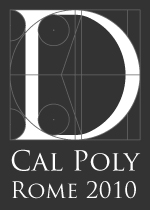The question of translation is one that looms constantly in our minds as students of architecture and never more so than with dealing with a typology with so much historical baggage such as the ever-present Roman Catholic Church. What is it that makes it obvious that as soon as that threshold is crossed one has entered a sacred space? Form has nothing to do with it; as we’ve discovered form is born from the ritual and as such holds no more power over our senses than the materials used. A good architectural translation searches beyond simple form and finds the essence of what is there to give light to something new. In churches it’s about the feeling of awe that comes with each crossing of the threshold. Whether it’s with the use of light or the change in the quality of air, there is something tangible that stirs feelings of amazement that can make even the firmest non-believer contemplate the existence of something greater.
A phenomenon that I have discovered to be uniquely Roman is that one is never farther than a cobblestone’s throw away from a church. It’s easy to walk around and experience this sense for oneself and we begin to feel aware of when a translation of this sort functions and when it does not. The Jubilee Church, for example is a building that in my opinion translates too directly and loses the essence along the way. I remember opening the door, crossing the threshold, and feeling the same as if I’d entered my living room. It had all the makings of a church, the altar, the aisle, the pews, but nothing there made me feel awestruck. It became very obvious that this example of translation was missing something, it was missing the essence of churchiness, that sense of wonder and almost insignificance compared to the existence of something greater that most feel when entering a sacred space and that is what distinguishes a good translation from a bad translation.
image in progress
Leave a Reply
You must be logged in to post a comment.
